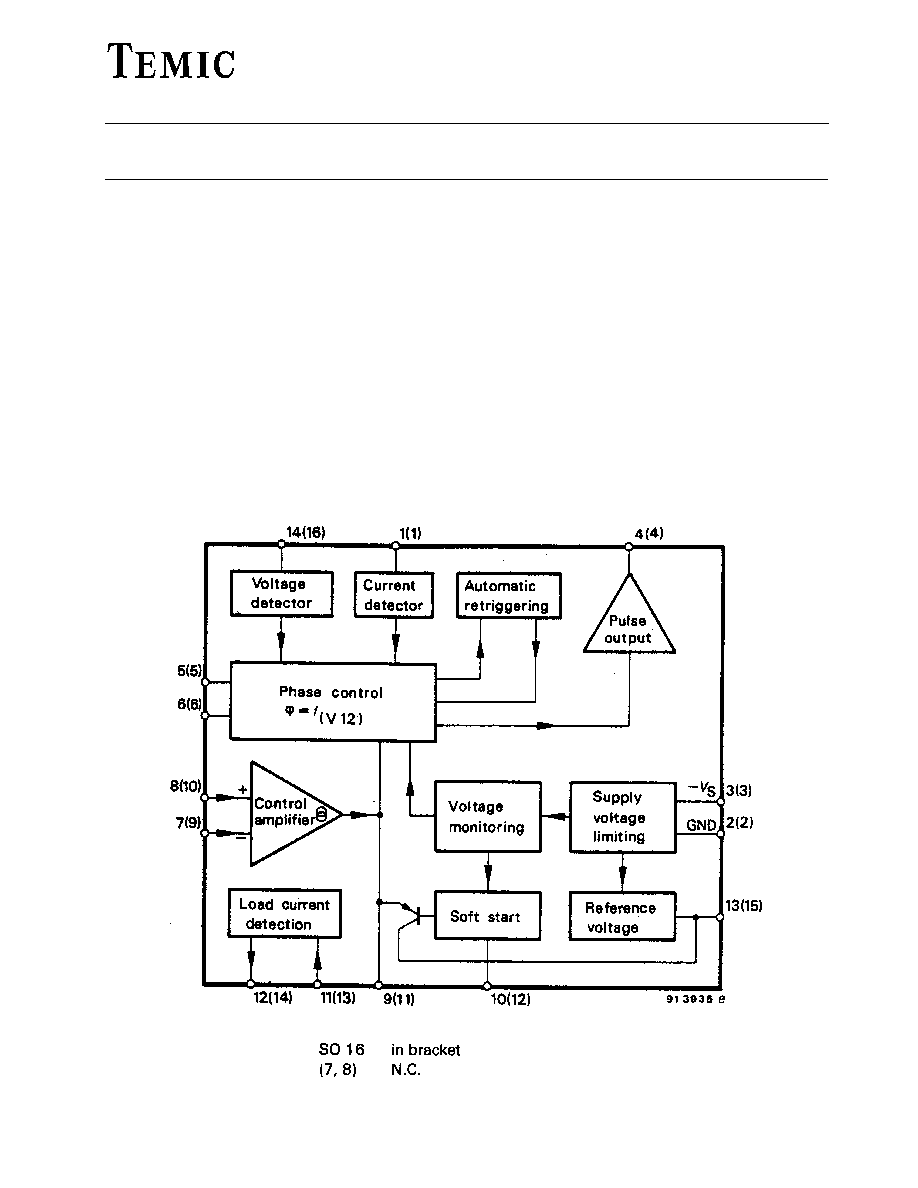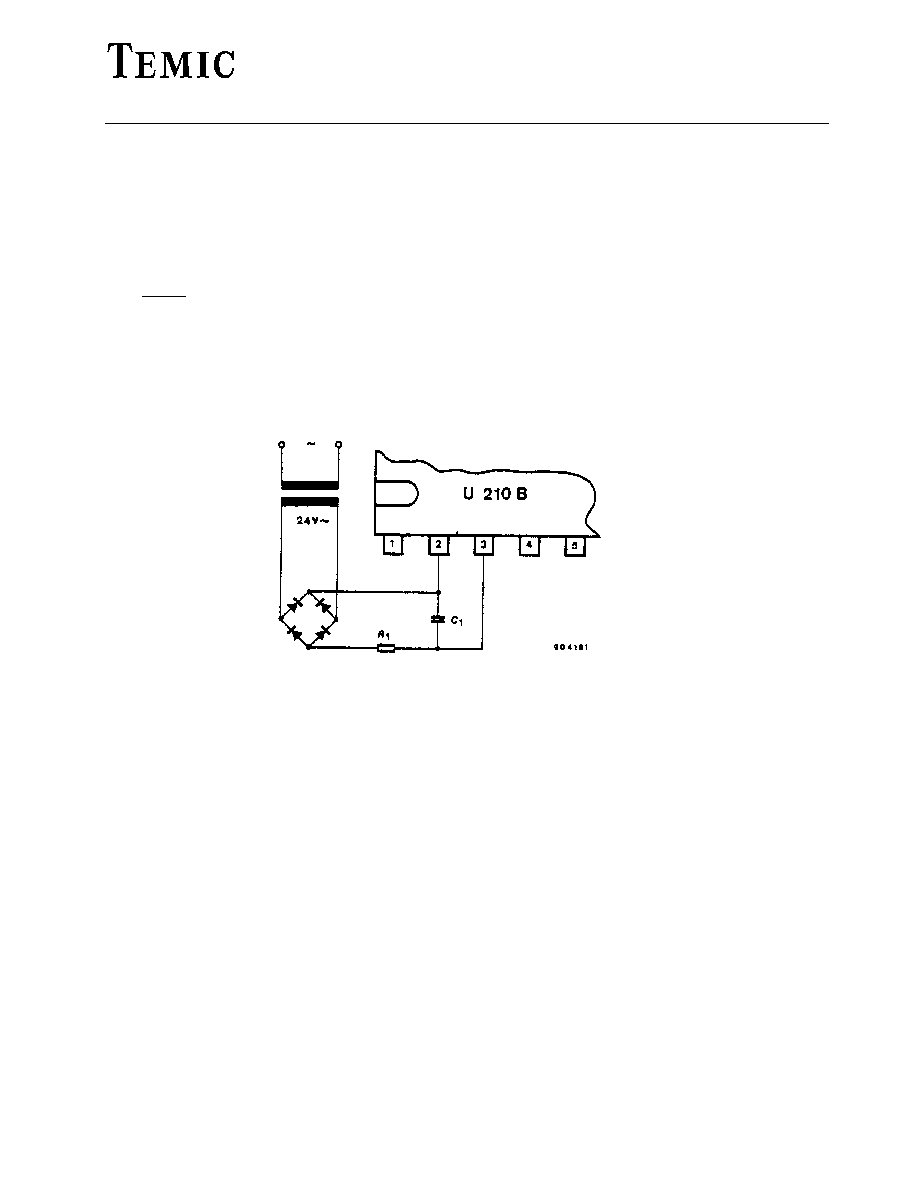 | –≠–ª–µ–∫—Ç—Ä–æ–Ω–Ω—ã–π –∫–æ–º–ø–æ–Ω–µ–Ω—Ç: U210B | –°–∫–∞—á–∞—Ç—å:  PDF PDF  ZIP ZIP |

TELEFUNKEN Semiconductors
U 210 B / U 210 B≠FP
1
Preliminary Information
Phase Control Circuit ≠ Load Current Feedback Applications
Technology: Bipolar
Features
D Externally controlled integrated amplifier
D Variable soft start
D Automatic retriggering
D Voltage and current synchronisation
D Triggering pulse typ. 125 mA
D Internal supply voltage monitoring
D Temperature constant reference source
D Current requirement
3 mA
Case:
DIP 14, SO 16
Figure 1 Block diagram

TELEFUNKEN Semiconductors
U 210 B / U 210 B≠FP
2
Preliminary Information
Figure 2 Block diagram with external circuitry
Open loop control with load current compensation

TELEFUNKEN Semiconductors
U 210 B / U 210 B≠FP
3
Preliminary Information
Description
Mains supply
The U 210 B is fitted with voltage limiting and can therefore be supplied directly from the mains. The supply voltage
between Pin 2 (+pol/
) and Pin 3 builds up across D
1
and R
1
and is smoothed by C
1
. The vaIue of the series resistance
can be approximated using:
V
M
≠V
S
2 I
S
R
1
=
Further information regarding the design of the mains supply can be found in the data sheets in the appendix. The reference
voltage source on Pin 13 of typ. ≠8.9 V is derived from the supply voltage. It represents the reference level of the control
unit. Operating using an externally stabiIised DC voltage is not recommended.
If the supply cannot be taken directly from the mains because the power dissipation in R
1
would be too large, then the
circuit shown in the following Figure 3 should be employed.
Figure 3 Supply voltage for high current requirements
Phase control
The function of the phase control is largely identical to that of the well known components U 111 B and TEA 1007. The
phase angle of the trigger pulse is derived by comparing the ramp voltage, which is mains synchronised by the voltage
detector, with the set value on the control input Pin 9. The slope of the ramp is determined by C
2
and its charging current.
The charging current can be varied using R
2
on Pin 5. The maximum phase angle
a
max
can also be adjusted using R
2
.
When the potential on Pin 6 reaches the nominal value predetermined at Pin 9, then a trigger pulse is generated whose
width t
p
is determined by the value of C
2
(the value of C
2
and hence the pulse width can be evaluated by assuming 8
ms/nF).
At the same time, a latch is set, so that as long as the automatic retriggering has not been activated, then no more pulses
can be generated in that half cycle.
The current sensor on Pin 1 ensures that, for operation with inductive loads, no pulse will be generated in a new half cycle
as long as current from the previous half cycle is still flowing in the opposite direction to the supply voltage at that instant.
This makes sure that "Gaps" in the load current are prevented.
The control signal on Pin 9 can be in the range 0 V to ≠7 V (reference point Pin 2).
If V
pin9
= ≠7 V then the phase angle is at maximum =
a
max
i .e. the current flow angle is a minimum. The minimum phase
angle
a
min
is when V
pin9
= V
pin2
.
Voltage monitoring
As the voltage is built up, uncontrolled output pulses are avoided by internal voltage surveillance. At the same time, all
of the latches in the circuit (phase control, soft start) are reset and the soft≠start capacitor is short circuited. Used with
a switching hysteresis of 300 mV, this system guarantees defined start≠up behaviour each time the supply voltage is
switched on or after short interruptions of the mains supply.

TELEFUNKEN Semiconductors
U 210 B / U 210 B≠FP
4
Preliminary Information
Soft≠start
As soon as the supply voltage builds up (t
1
), the integrated soft≠start is initiated. The figure below shows the behaviour
of the voltage across the soft≠start capacitor and is identical with the voltage on the phase control input on Pin 9. This
behaviour allows a gentle start≠up for the motor.
Figure 4 Soft≠start
C
3
is first charged with typ. 30
mA. The charging current then increases as the voltage across C
4
increases giving a
progressively rising charging function with more and more strongly accelerates the motor with increasing rotational
speed. The charging function determines the acceleration up to the set point. The charging current can have a maximum
value of 85
mA.
Control amplifier
The integrated control amplifier with differential input has a bipolar current output, with typically
±
110
mA at Pin 9 and
a transmittance of typ. 1000
mA/V. The amplification and frequency response are determined by external circuit. For
operation as a power control, it should be connected with Pin 7. Phase angle of the firing pulse can be adjusted by using
the voltage at Pin 8. An internal limiting circuit prevents the voltage on Pin 9 becoming more negative than V
13
+ 1 V.
Load current detection, Figure 2
Voltage drop across R
8
, dependent of load current, generates an input≠current at Pin 11 limited by R
5
. Proportional output
current of 0.44 x I
11
(CTR) is available at Pin 12. It is proportional with respect to phase and amplitude of load current.
Capacitor C
3
integrates the current whereas resistor R
7
evaluates it. The voltage obtained due to load current
proportionality, can be used according to the application i.e., load current compensation or load current regulation.
Pulse output stage
The pulse output stage is short circuit protected and can typically deliver currents of 125 mA. For the design of smaller
triggering currents, the function I
GT
= f (R
GT
) has been given in the data sheets in the appendix. In contrast to the U 111 B
and the TEA 1007, the pulse output stage of the U 210 B has no gate bypass resistor.
Automatic retriggering
The automatic retriggering prevents half cycles without current flow, even if the triac is turned off earlier e.g. due to not
exactly centred collector (brush lifter) or in the event of unsuccessful triggering. After a time lapse of t
pp
=4.5 t
p
is
generated another triggering pulse which is repeated until either the triac fires or the half cycle finishes.

TELEFUNKEN Semiconductors
U 210 B / U 210 B≠FP
5
Preliminary Information
General hints and explanation of terms
To ensure safe and trouble≠free operation, the following points should be taken into consideration when circuits are being
constructed or in the design of printed boards.
D The connecting lines from C
2
to Pin 6 and Pin 2 should
be as short as possible, and the connection to Pin 2
should not carry any additional high current such as the
load current. When selecting C
2
, a low temperature
coefficient is desirable.
Figure 5 Explanation of terms in phase relationship




